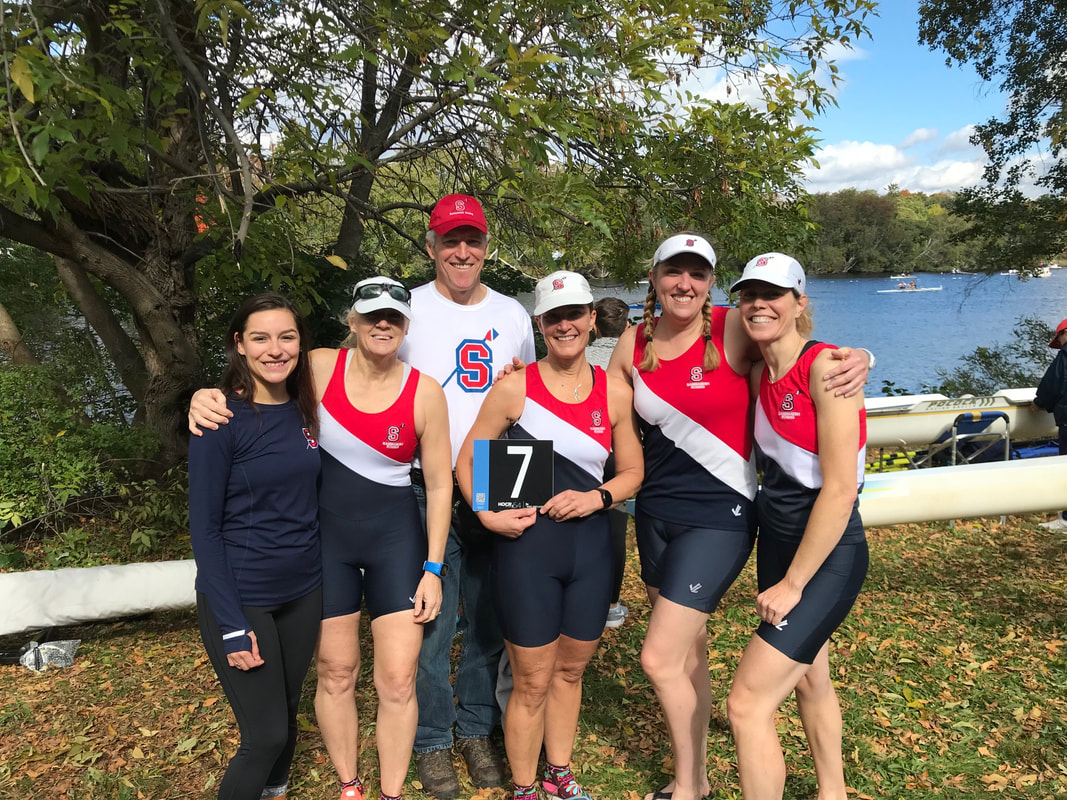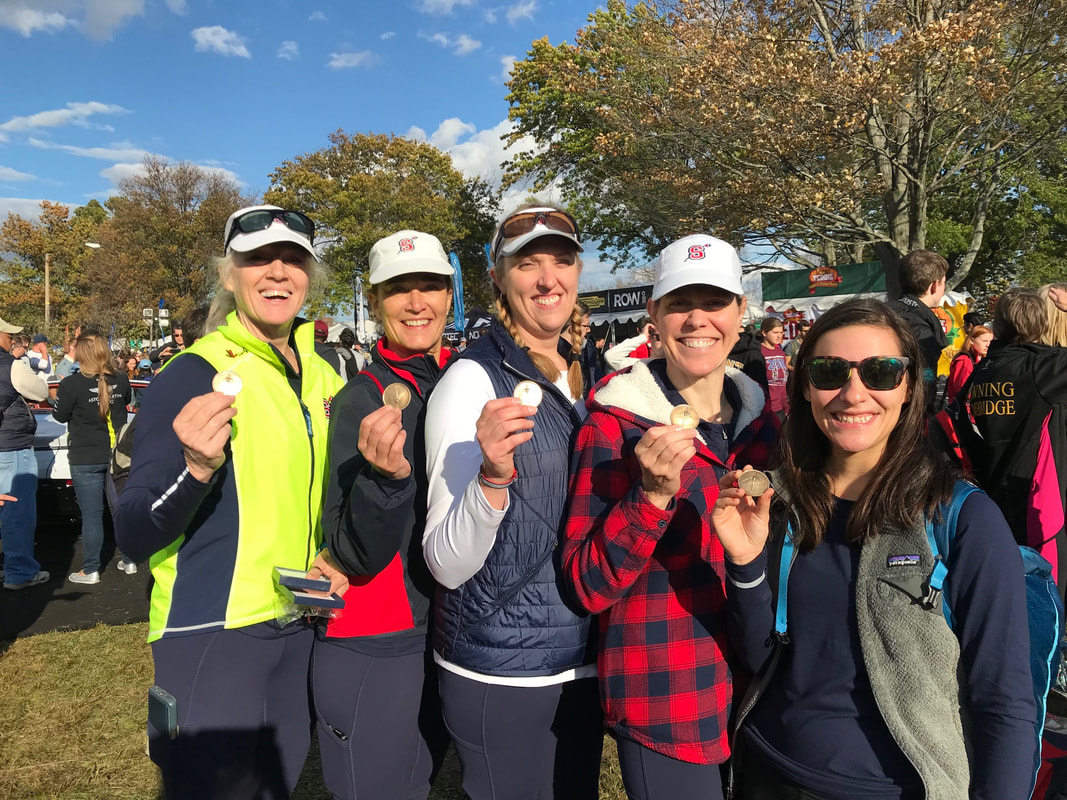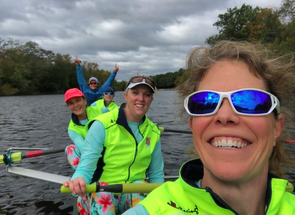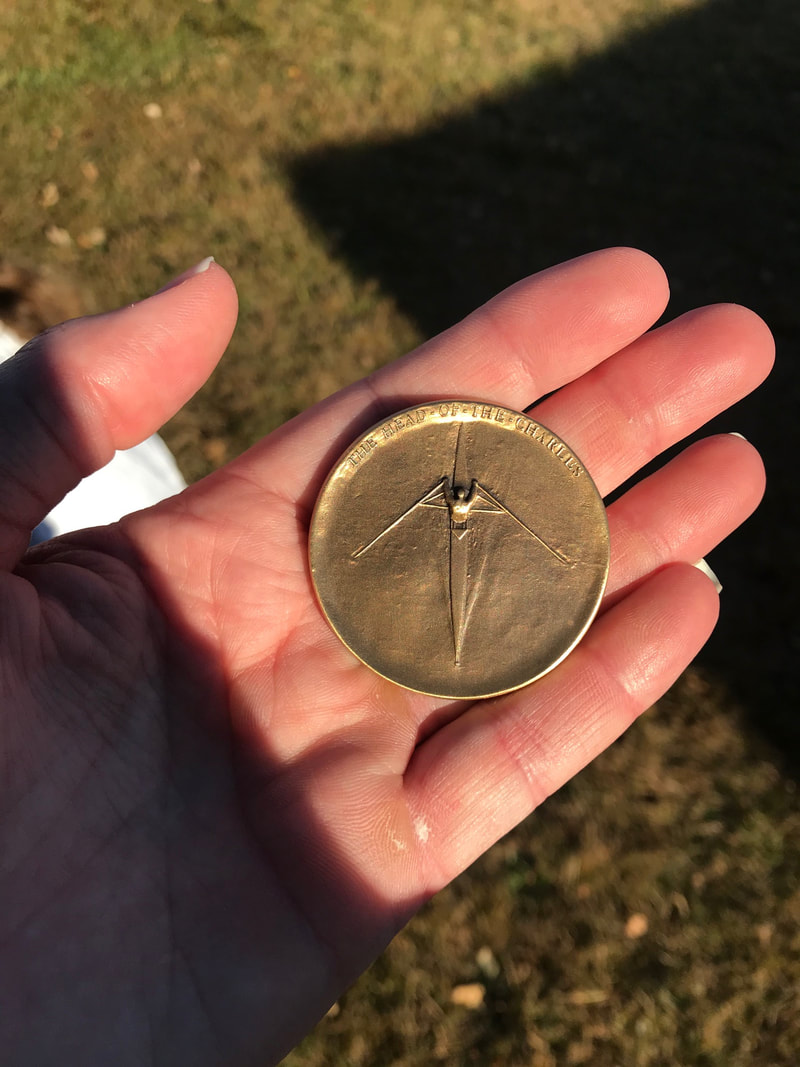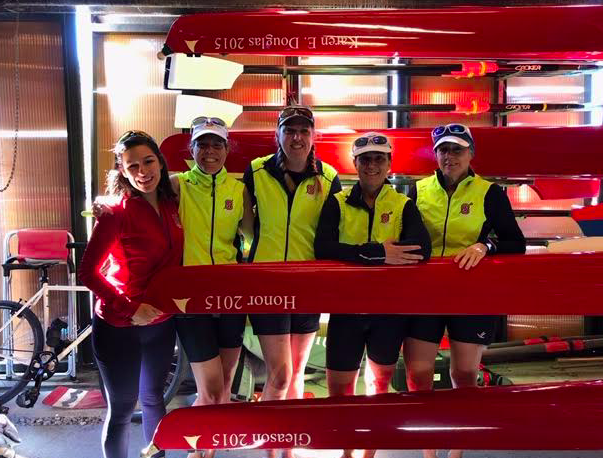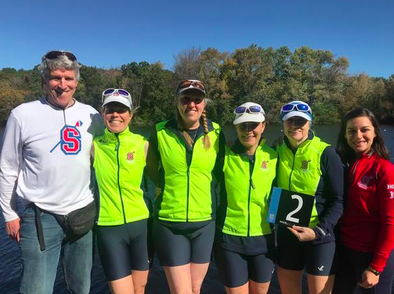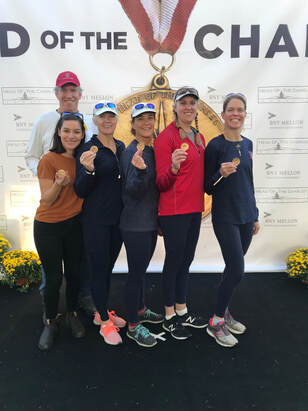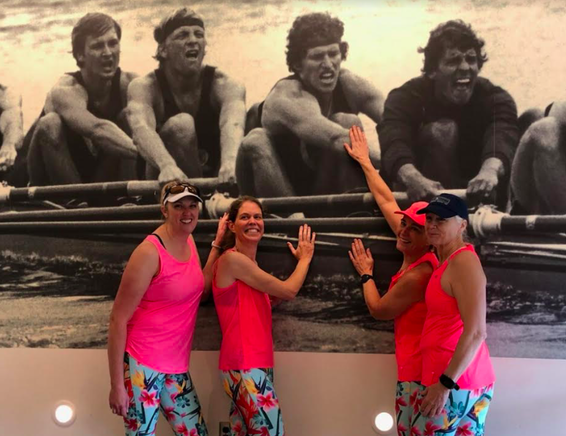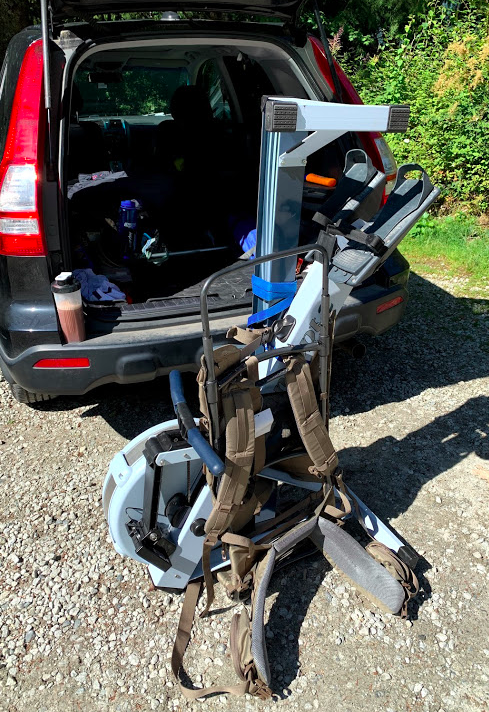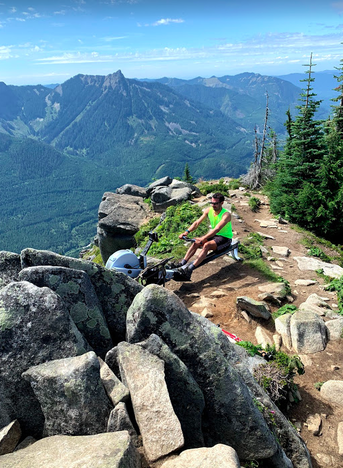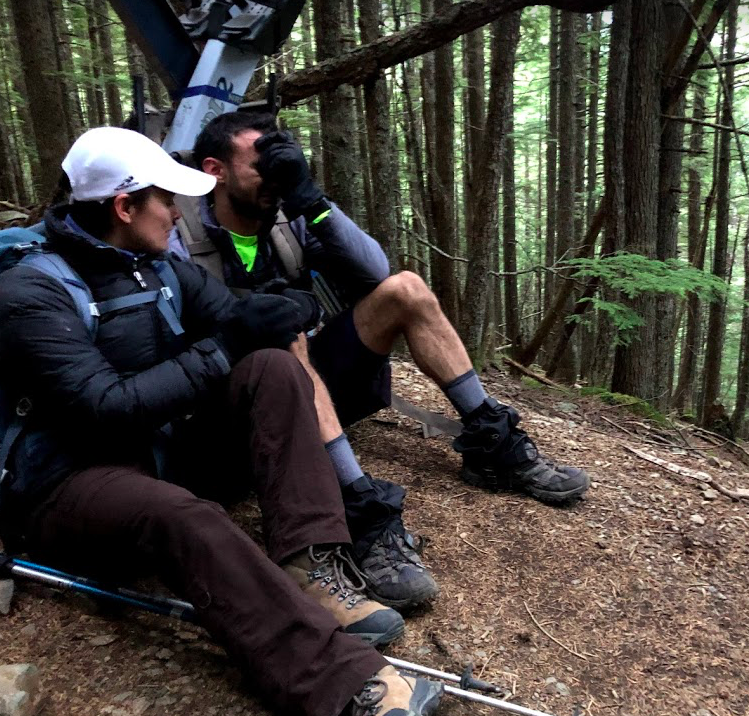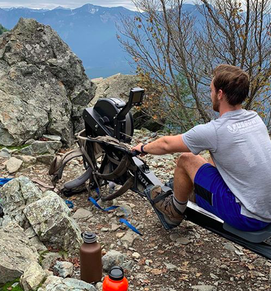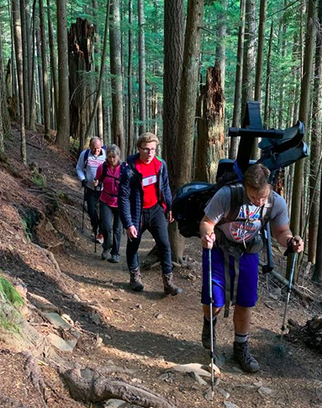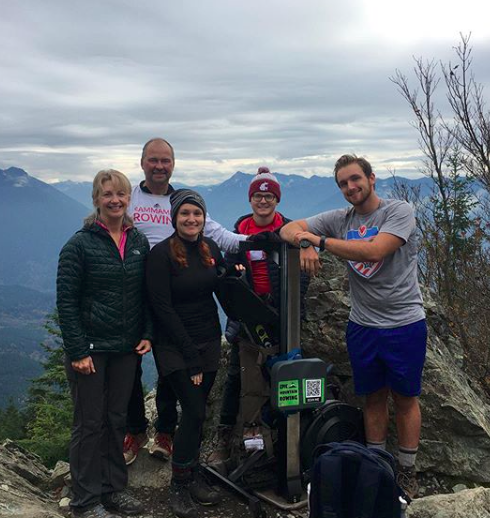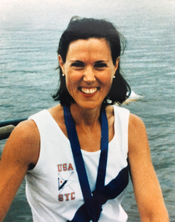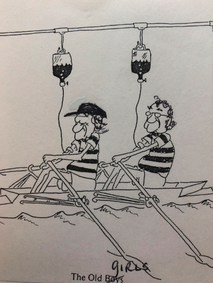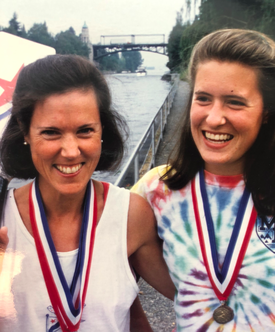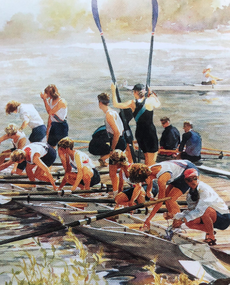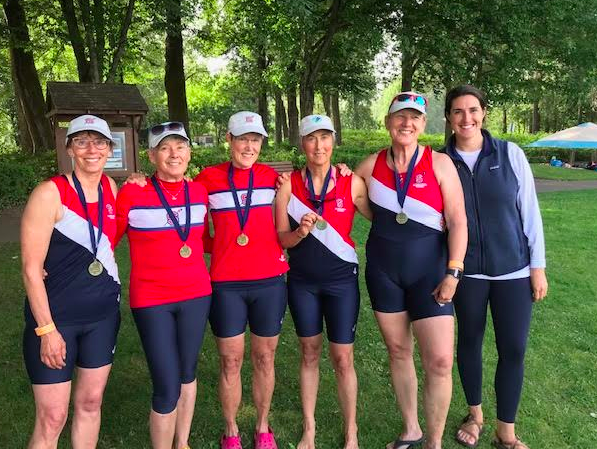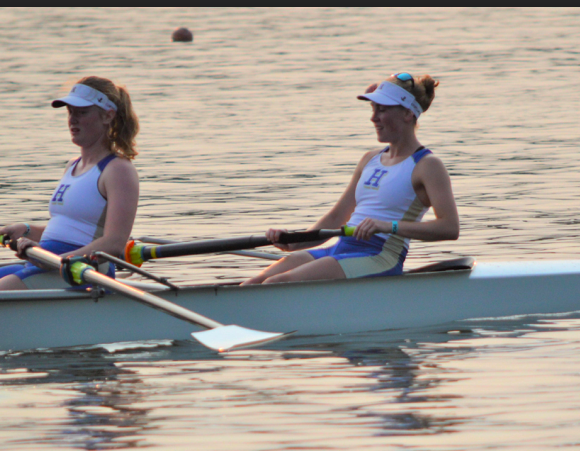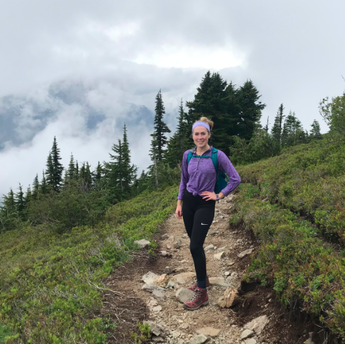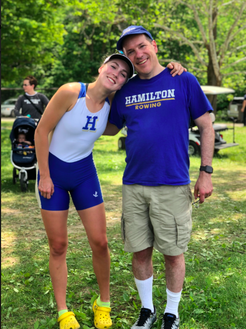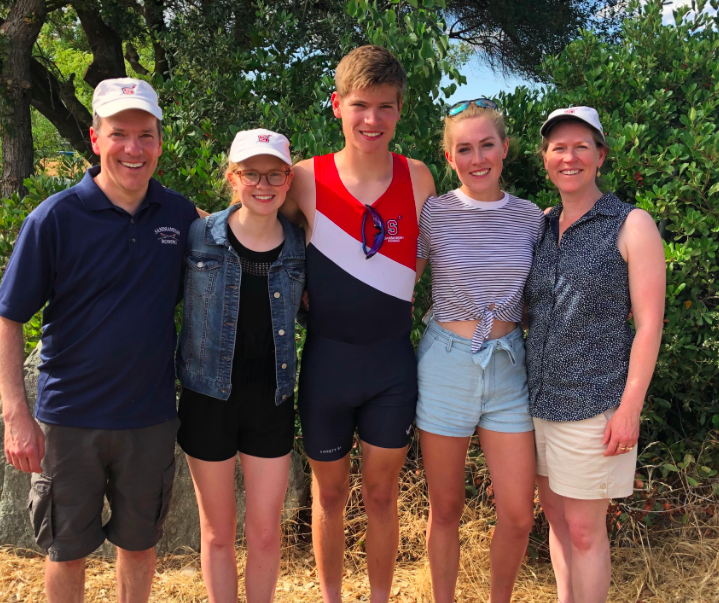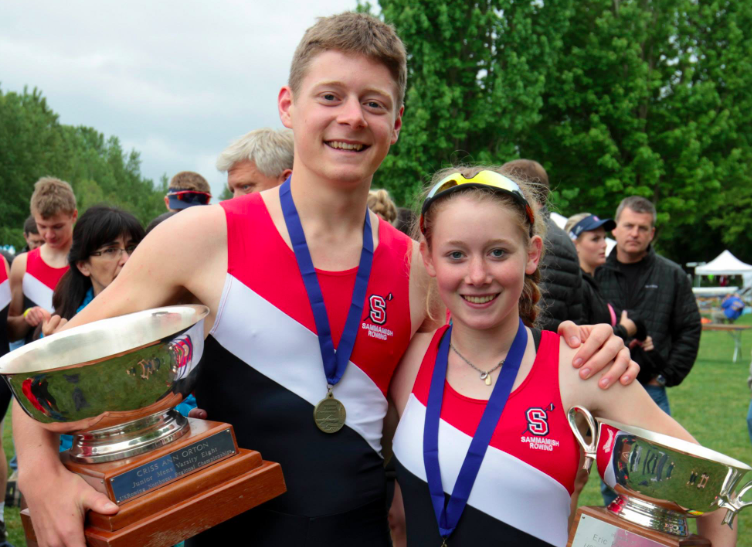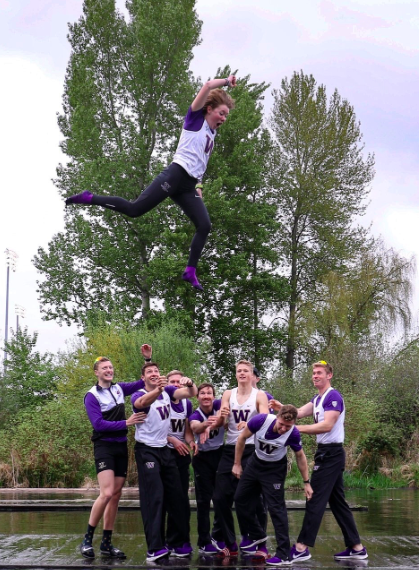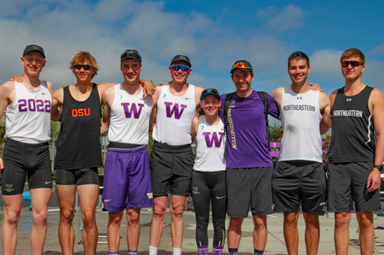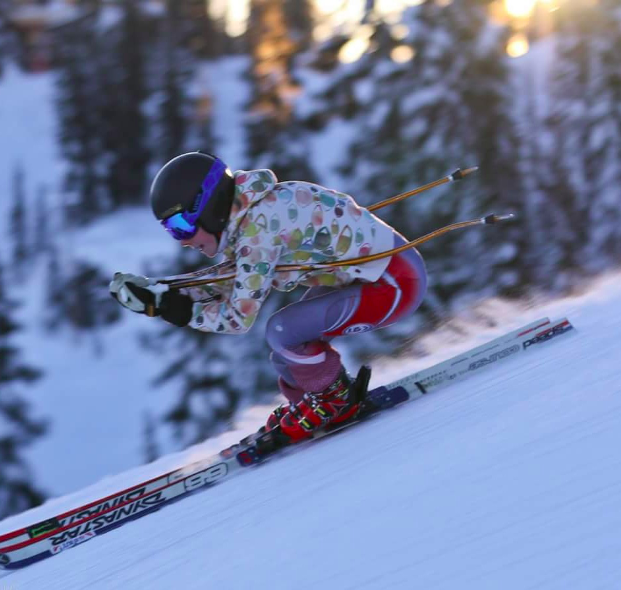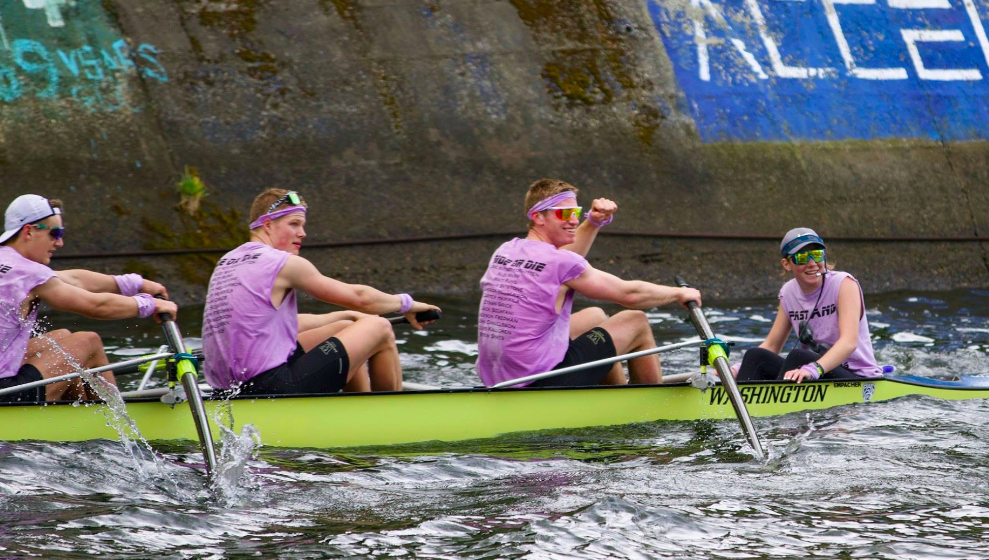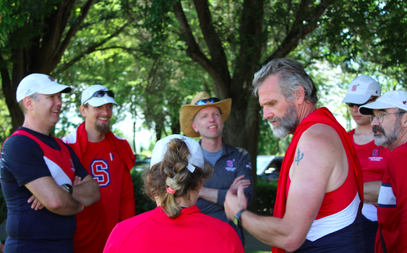Sally Solaro, Barb Calvert, Trisha Miller, Jennifer Teschke, and Genevieve Carrillo have rowed together as a boat for the past two Head of the Charles races in the Women’s 50+ category. These five women have been with SRA as long as eight years to at least four. All of them said that the reason they came together as a boat was because of their rowing coach- Tom Woodman.
What was also new was their coxswain, Genevieve Carrillo. Calvert met Carrillo on a plane. Calvert said, “We were coming back from the HOCR the year before. She (Carrillo) was sitting next to me on the plane so we had a few conversations. She had just coxed for the Cambridge Boat Club men. They had flown her out there and she spent the week going up and down the course with them. The men taught her how to cut every single curve and corner possible and what her sightlines should be. I asked ‘well would you ever be interested in coxing for us?’ We ended up exchanging phone numbers.”
They got an extra boost of motivation when they passed other boats. Solaro said, “We were bow 7 in that race and passed about 3 boats.” Eventually the women finished and were told by Scott Winter that they placed second. Later on they verified it. They had won a silver medal at the HOCR. Calvert said, “We were very confident that we would make the top ten, but we wanted top five.” It turns out they certainly did make the top five with a boat from Cambridge being the only one to beat them. It’s important to point out that this Cambridge boat was comprised of Olympians and National Champions whereas the Sammamish boat had only one rower with collegiate rowing experience. Everyone else had learned as adults, two at SRA. Fast forward to this year and the women again made top five, earning a bronze medal in the same race. While they still felt confident in each other, each woman experienced some setbacks. Miller said, “Going into 2019 I wasn’t less confident with the boat, I was less confident with myself.” Miller had been experiencing shoulder problems, and Calvert had broken her toe and hand earlier in the year so they had to work hard to keep up with training. For all of these women, training was brutal. Not only did they practice as a team on the water and on the ergs putting in several hours of hard work a week, but on top of that they trained individually. To achieve the success they had each woman had to put in numerous hours on their own spending extra time in the gym. Sacrifices were made to go the extra mile, and training without a teammate constantly by your side can be hard. Calvert said, “Training by yourself can be boring but I find the focus and dedication in this process is important. It carries into the boat. When I get into the boat I think about all the hours, the focus, dedication I've put in. Now it's all about just getting the job done.”
Armed with the superior Sammamish Rowing coaching, and hours upon hours of training on their own, these five women were able to succeed year after year at the HOCR. Each of them had their own piece of advice towards creating a successful boat. Most of the successful characteristics of their boat included trust, chemistry, laughter, hard work, and practice. Miller said, “I’m always talking to the juniors about this, but we always assume the best intent. The trust is there because I know they all trust me too. They know I’m working as hard as I can and they are too. There’s a seed of doubt in some boats whether everyone is trying hard enough and training on their off days, and with this boat there isn’t that doubt.”
This boat from SRA’s 5am team has enjoyed incredible success and they credit not only themselves, but a talented coxswain, loyal coach, and supportive team. These women who wear matching loud leggings on the Friday before their HOCR race, are both relaxed and intensely focused. Their training was an intense mix of personal dedication and trust in their coach, Tom Woodman. Their practically daily dedication to hours of difficult, and sometimes very painful, workouts yielded results to be very proud of.
They look forward to a growing masters team as Sammamish welcomes in new rowers every year. While they would love to row in more HOCR events together, they leave their future in the trusted hands of Tom Woodman. They trust his process without question. Congratulations Sally, Trisha, Barb, Genevieve, and Jennifer! Sammamish Rowing looks forward to more success from you all and great memories! As rowers, we learn to push ourselves to the limit. We encounter moments in which we discover our potential and realize just how far we can go to achieve a goal. These moments and experiences look different for everyone, especially Sammamish Rowing Association’s (SRA) coach, David DeWinter. DeWinter joined SRA over 10 years ago as a rower with no prior experience. Since then, his many years of hard work, smart training, and willingness to learn new things have resulted in multiple medal-winning performances at some of the world's most prestigious regattas for masters, including the Head of the Charles, Masters' Nationals, and Masters' Worlds. He has also spent some time as a coach for both masters and juniors to share what he’s learned during his time at SRA. 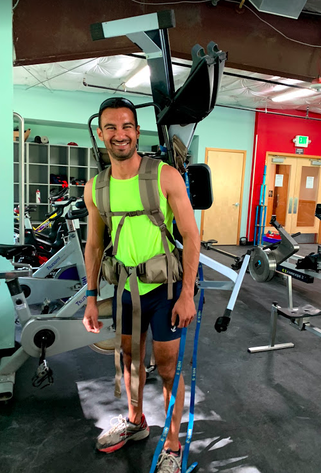 DeWinter fiddling with his erg set up at the Hod Fowler Boathouse DeWinter fiddling with his erg set up at the Hod Fowler Boathouse “Throughout my time at SRA, I slowly learned the importance of mindset and its impact on successful performances, and I had to find my own ways to train it. I came up with these challenges outside of rowing that would help me become a mentally tougher person. I figured if I could do these things, then racing in a single for four or so minutes would be a piece of cake.” These challenges included car camping for 7 days while hiking 100 miles solo along the Mountain Loop Highway, and walking 110 miles around King County without set places to sleep—from Redmond to Edmonds to South Seattle and back across I-90. This summer, DeWinter was itching for something new, and with a milestone birthday encouraging him to go big, he came up with the idea for Epic Mountain Rowing. He stumbled on the story of Matthew Disney—an ex-Royal Marine who walked between and climbed the 3 highest peaks in the UK all while carrying an erg (rowing machine), over 700km in total. At the top of each peak, Disney rowed the height of the mountain. “I thought this guy was crazy,” DeWinter added. “His challenge was called the ‘Three Peaks Challenge,’ which made me think of the ‘North Bend Triple Crown’ challenge, and what it would mean to apply the rowing machine to that.” The North Bend Triple Crown is a local bragging right bestowed on hikers who scale Mt. Teneriffe, Mailbox Peak, and Mt. Si in 24 hours. The mountains range in height from 3900ft to 4800ft, so taking an erg up each of them in the same amount of time was non-trivial. “It was definitely crazy,” DeWinter added, “but at least it seemed possible.”
That’s when DeWinter learned about external frame backpacks. Hikers use these packs to secure all sorts of loads to the rigid frame they provide. For example, hunters often use them to carry out large game from the backcountry. He ordered a pack and got to work on attaching the erg. It took him several attempts, some including boat straps, bungees, and other configurations, before he found something that worked. He would test each configuration by walking longer and longer distances. “At some point I thought, ‘Okay, I better try carrying this up a mountain.’” 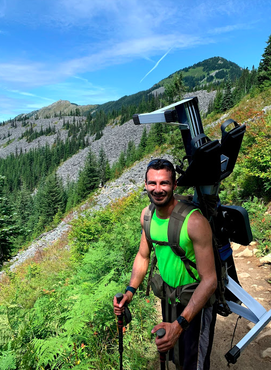 A test hike with the erg A test hike with the erg In early August, Coach Ethan Currie and DeWinter went to Bandera Mountain and made their way up slowly with the erg. “It was so difficult, because I had not done a lot of training to do a whole mountain,” he admitted. Even though the 8-mile hike took around seven hours to complete, they were successful, and the challenge became real. Joining the junior rowers’ Ergathon fundraising efforts that will end on November 15th, DeWinter created social media for the challenge he branded Epic Mountain Rowing. On August 14th, the day after hiking Bandera, his adventure was announced, and he was committed. While DeWinter was experimenting with the frame pack, junior rowing alumnus, Alex Sitzman, asked if he could join in on the challenge. Sitzman trained independently from DeWinter, but they collaborated on pack set-up before Sitzman went to Oregon in mid-September to begin his first year of college. Training was unique. Unlike a marathon or weight lifting competition there were no training plans to buy or personal trainers to hire. DeWinter said about his training, “Here’s what I knew. I’d be hiking with a bunch of weight, and I’d be hiking for 30 miles. Those were the key components. The training involved identifying my current weaknesses, and being laser-focused on correcting as much as possible before the actual event. For example, I have to be on my feet for 30 miles, so I need to practice getting that much mileage without worrying about blisters. A lot of the training involved walking, running, and hiking without the pack for many miles. This told me whether or not my shoes were right. If I felt debilitating pain, I needed to change something. “The second part of it was handling the weight. This one I didn’t feel as regimented about. Due to external pressure I had to be time-efficient with my workouts, so I did lunges with weights up and down the path and focused on heavy lifts in the gym. I couldn’t make it up to the mountains as much as I originally intended, but I went just enough to feel that I had fixed my major problems. About four days before the event, I did one last hike up Mount Si with the erg, and I felt incredibly powerful and confident for the challenge.
DeWinter had recruited a team of volunteers for each mountain for both Sitzman and himself. Their job was to help with safety, provide support, talk to people on the trail who were curious about the group, and document the effort for social media. Although it seemed like smooth sailing on the day, DeWinter had to deal with some stress after a last-minute volunteer cancellation and a nervous rush to get the GPS tracking system running about 15 minutes before the start time. With all of that out of the way, all he had to do now was focus on the mountains. At 1 PM, they set off on the trail to the summit of Mount Teneriffe. The 13-mile trail was the longest of the 3 mountains, but despite that, DeWinter mentioned that the first peak went relatively well. He kept a good pace and felt confident about his progress. His strategy for each mountain included planned stops for refueling and rest as well as tracking landmarks to help break up the mountain into manageable chunks. 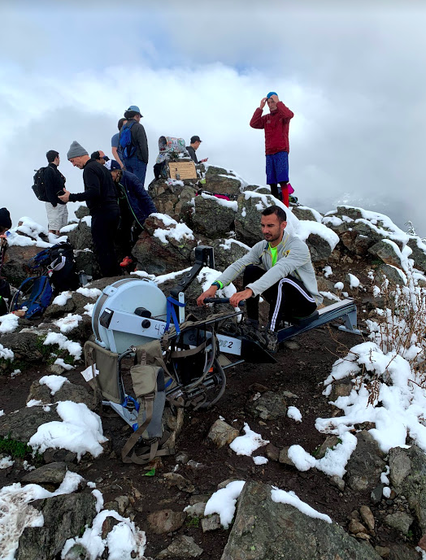 At 8:30 PM, DeWinter moved on to Mailbox Peak, where he began to feel the difficulty of his challenge. In the darkness, he and his crew marched onward, but DeWinter began to struggle. “I didn’t want to stop,” he said, “but the environment and the circumstances made me really frustrated.” Even though he had broken the trail down into sections, and he was aware that the boulder field had many false summits, the trail just seemed to be longer and more difficult in the dark. After summiting at midnight, DeWinter was tired, agitated, and clearly not at the top of his game. In a moment of clarity, he recognized his struggle and asked his friend and SRA 5am rower Trish Miller to videotape him. It was important to him not to hide struggles from the camera. “There are so few chances that I get to be real with an audience about struggle. I know sometimes athletes see us [coaches] as invincible, and it was important to me to break down that myth.” That exercise, while excruciating, helped him calm down and rediscover his rhythm. He and his crew eventually made it off Mailbox about 3 hours later.
“5 minutes after Celine and I sat together, I was in good spirits to continue. My body clearly needed some way to deal with the stress, and in that situation, crying was the path of least resistance. Having a supportive crew to feel comfortable enough to do that in front of was also important.” Despite the struggle and moments of darkness on his adventure, DeWinter ultimately succeeded and finished his Triple Crown Challenge in under 24 hours. The final time was 21 hours, 25 minutes, and 19 seconds. When asked how he felt once he had finally finished, he said, “It’s interesting that there wasn’t the grand sense of relief that you might expect. Towards the end of Si, maybe the last 1,000 meters, it wasn’t a sprint to the finish line. At that point I knew I could finish in the time limit, and the pressure dissolved. I just wanted to get the erg to the car. After some moments of reflection, it was really satisfying to feel this sense of connection that we [the SRA community] could make together in such a short amount of time: Alex and I doing this crazy adventure, volunteers going with us who didn't know each other before this... We had created this crew that was kind of like the Lord of the Rings. Then there was everyone watching, donating, following along, and it just felt so powerful. My little idea created such a broad impact, and it felt quite special.” While DeWinter and Sitzman were just individuals taking on an extraordinary challenge, they had the support of the SRA community behind them and physically with them on their journey. “I think that a characteristic of a really powerful community is the ability for the people inside of it to do extraordinary things, and the community rises to support them,” DeWinter said. “Sammamish is one of those communities.” 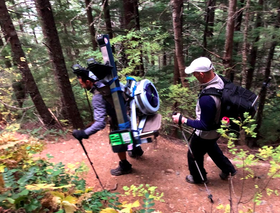 Congratulations Dave on one of the most incredible athletic feats you've ever accomplished! Dave and Alex ended up raising just over $11,000 for the Sammamish Rowing Scholarship Fund, which is more than double their goal! Continue to read “Rower Stories” from the SRA website to discover more amazing individuals of our rowing community.
One of those individuals is a recent alumni of our high school junior rowing program. Alex Sitzman, SRA class of 2019, spent considerable time at the boathouse this past summer volunteering with the summer middle school rowing program. He was also keeping up with his training by partaking in a summer rowing program when he noticed David (Dave) DeWinter fiddling around with an erg and a backpack. DeWinter was trying to figure out how to somewhat comfortably carry an erg for a challenge inspired by Matthew Disney- an ex-royal marine in the UK who hiked up three of the UK’s highest peaks to raise money for a cause important to him. DeWinter was applying the same idea to the local North Bend Triple Crown Challenge. DeWinter’s plan was to carry an erg up Mount Teneriffe, Mailbox Peak, and Mount Si in 24 hours while also erging the height of each mountain at the top to raise money for the scholarship fund in tandem with SRA’s Ergathon.
“Sammamish has been one of the biggest parts of my life for a long time,” Sitzman said while reflecting on why he wanted to join DeWinter in climbing three peaks with an erg on his back. “I’m going on almost seven years since I started rec (the middle school program at the time) there. It’s hard to remember a time when I wasn’t part of SRA. The structure and team helped me develop as a person. I became so much more fit, and structured, and overall SRA improved every aspect of my life.” In addition to the personal gains Sitzman enjoyed, he saw first hand the impact of the scholarship fund on his friends’ lives and the opportunity it gave them to row. “ It was a personal objective for me to raise money for that (the scholarship fund) specifically. I’ve seen it’s impact first hand,” he said. The few months leading up to October 12th at 1:00pm, the official start time of the Epic Mountain Rowing challenge, Alex had nothing but support from friends and family. Even though a few considered him a bit crazy they still gave him their full support. Eventually October 12th did come and Alex flew from Oregon to Seattle after his Friday 6K test at practice. He prepared by eating a large bowl of pasta for breakfast and set out to tackle Mount Teneriffe first. Sitzman reported that Mount Teneriffe was nerve racking, but also helped him set a good pace. “I was feeling great all up Teneriffe. I started going up and knew I could keep a pretty fast pace,” he said. It was Mailbox Peak, the second mountain, where he began to feel the fatigue set in. “Mailbox I had done before, and I remembered how unbelievably long it feels to do,” Sitzman mentioned. The boulder field near the top was incredibly hard for him to navigate, and he found that going up and down that section took a huge toll on his knees. His rests were more frequent, and he admitted that as he came down Mailbox Peak he realized he wasn’t getting in enough fuel. Eventually he made it down Mailbox and headed to his last mountain- Mount Si. He took a long break to give his knees a rest before starting his final ascent. Going up Mount Si was slow. Sitzman was not on pace. By the time he reached the last tenth of the mountain, he had gotten to the point where his legs hurt, but that wasn’t what was slowing him down. He said he couldn’t get enough energy to pick up a leg up and move it forward. Somehow he persevered.
One thing that kept Sitzman moving was a message left on the Epic Mountain Rowing Instagram page by his friend Landon Fick. Fick, also on the Oregon State Crew Team, told Sitzman their rowing coach was watching Sitzman’s effort via social media and his GPS tracker. That truly shows the mental power a crew coach has over his or her rowers! A little over 24 hours since the start of his journey Sitzman finished. There was no grand celebration or triumphant post-hike speech. Sitzman took off his pack with the erg, got in his moms car, and instantly fell asleep from his sheer exhaustion. That night he flew back to school, woke up for his 6:30am practice, and completed his Monday morning erg workout with the rest of his teammates like normal. “It felt like a weird dream,” Sitzman said. A few teammates knew what he had done, and his coach was quite proud of his effort. His muscles were so sore at this point that a typical ten minute walk to class took him thirty minutes. All in all he recovered, and can now say he has completed the Triple Crown with an erg on his back in just over 24 hours. Together, he and DeWinter raised over $10,000 for the scholarship fund.
It was 1985 when Sue McKain’s husband stumbled across the Corinthian Yacht Club newsletter that had an announcement. The newsletter stated that any woman who wanted to learn to row could show up at the University of Washington boathouse and learn. The women would then have the opportunity to race in the Opening Day Regatta against women who belonged to other yacht clubs. McKain took the opportunity and was coached by Dick Erickson for three months. “That got me hooked,” McKain said.
Before her personal start in rowing in 1985, McKain was already familiar with the sport. Her dad rowed at the University of California, Berkeley in 1931 as a Freshman. When his family moved to Los Angeles, he was on the first men’s crew team at UCLA. He was in the 1932 Los Angeles Olympics trials in a coxed four. McKain’s father had a whole album dedicated to rowing photos. She remembers thumbing through the album often. “I was always fascinated by the sport,” she said. Before coming to row for Sammamish Rowing Association (SRA) in 2015, McKain had rowed many years starting with Conibear, Seattle Yacht Club and Montlake Rowing Club. Her early days of rowing took her on many adventures including Masters FISA regattas in Scotland, France, and Italy. Just like her dad she has a thick album dedicated to preserving the memories of her ongoing rowing career. Inside were photos from practices and races, poems written by her teammates about the sport, posters from renowned regattas, crew comics, news articles, and even more precious pieces of memorabilia. When McKain retired, she no longer had to row with a group early in the morning. Her 4:30am alarms were now in the past, and she was hoping to join a new team. That’s when Paul Harvey suggested SRA. “He and I rowed together when he was part of Ancient Mariners and I was part of the Seattle Yacht Team. He said I had to come to SRA,” McKain added.
It wasn’t only friendships and good memories that the sport gave McKain. Rowing was a way for her to keep her mind off three cancer diagnoses. McKain had skin cancer a few years ago and just this past year went through treatments for breast and thyroid cancer. Thankfully McKain is currently cancer free and still rowing! “Life doesn’t stop,” she said when discussing how she got through her treatments. “You need to have something to look forward to. Rowing provided that.”
Every day she continues to make new memories, but one of her favorite rowing memories was at the 2016 San Diego Crew Classic. “It flew by,” she said. “It was such a great row. I felt that moment where it seems so easy even though you’re working so hard. We would've won it if it wasn’t for the Chinook’s composite boat! We still felt great about getting second place. The common focus, common excitement, common support where we all trusted each other was amazing.”
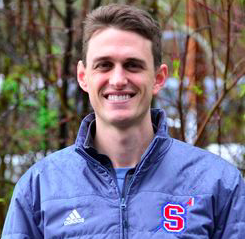 SRA Community, Earlier this week I notified the board of directors that I will be resigning from my position as executive director to accept an opportunity with the Woodland Park Zoo as their capital campaign senior manager. The decision to leave SRA was immensely difficult for me and my family. We love SRA and the opportunities this community has afforded us personally and professionally. However, with the arrival of our daughter this past spring Whitney and I have come to realize that the work-life balance and long-term career growth at the zoo will be a better fit for us in the years ahead. We have an incredibly competent staff and strong leadership in our board. I have offered to remain available on a volunteer basis to assist with critical tasks while the board searches for an executive director, and I am confident that our rowers will not be adversely impacted by the leadership transition. Thank you for the opportunity to serve you over the past six years. I am VERY proud of what we have accomplished together, and I am excited to see SRA continue to grow and prosper under new leadership. Steven Freygang From SRA Board President Dee WalkerOn behalf of the Board of Directors, I want to congratulate Steven on pursuing his next step in his career, and thank him for his leadership of SRA at a critical time. While we are sorry to see him go, we respect his decision and wish him and his young family well. During Steven’s tenure, SRA has blossomed into a nationally recognized rowing community, known for its excellence on the water at all levels and ages. A long-term strategic plan, highly talented coaches and staff, a new fleet, record enrollment, and fiscal health are among the many legacies Steven leaves behind. We will miss him.
The board has appreciated the transparent and productive engagement with Steven, particularly during inevitable moments that challenge the community, including the upcoming search for his replacement. In partnership with the board, we have already set in motion ways to ease the transition and help reduce any ambiguity for staff, parents, or rowers. I would like to share with you the following steps we are taking: First, we are grateful that Anne Corley has agreed to serve as Interim Executive Director. Anne has a long history and deep knowledge of SRA having served on the staff for the past three years, and before that on the SRA board of directors, including a term as president. Together with the help of the professional staff, Anne will keep this complex and growing organization running smoothly. Second, Leslie Moser will lead a search committee that consists of several board members and staff. We anticipate a great deal of competition for this role from national clubs and organizations, as well as local ones. As immediate past president of SRA Leslie knows well the values and competencies we are looking for, and will work with others to bring several finalists to the full board for final consideration. The search committee and board will work transparently, expeditiously, but thoughtfully to land a new leader worthy of this great, growing community. Please send any suggestions for candidates directly to Leslie by October 1. You can contact Leslie at [email protected] Finally, I want to thank the professional staff and coaches for their continued focus and commitment to make SRA a great experience for hundreds of rowers. We want to make sure you are fully supported during this transition so you can do what you do best: go fast and win! Please do not hesitate to reach out to me directly or any other member of the board if you have questions or concerns. Please join me in wishing Steven well, and thanking him for his stewardship of this great community. Thanks to him, and all of you, our best days are ahead of us. Dee Walker
Being able to learn from and overcome failures was pivotal to Kat’s progress. By January, when she joined the team, the other girls had learned the stroke and language of the sport. For example, on her first day on the water, she had no idea what feathering the oar meant. Throughout her novice spring, Kat figured out the language and raced at Brentwood, where she transferred and finished her high school rowing career. Although Kat finished her junior career elsewhere, she considers SRA her big rowing family. She said, “Rowing really changed the entire course of my life because it led me to do an extra year of high school, go to a boarding school, and eventually get recruited to college to row. The SRA boathouse has been one of my main communities back home. It’s really fun to have a place to go back to to work out and share this sport with others. It’s especially exciting to introduce the basics of this amazing sport to middle schoolers and adults.” Kat said. Currently, Kat coaches Learn to Row and Middle School summer programs. Her high energy and infectious smile can be seen around the boathouse all day, and instantly rub off on those who she coaches. The middle school participants love when she sprays them with the hose when the hot sun has been bearing down on them all practice long, and the adults enjoy her unwavering energy as she teaches the basics of the rowing stroke. One of her favorite Sammamish memories was as a coach. This year a particularly windy day forced all the teams to stay on land. “All the Learn to Row classes combined and did a bunch of erg sessions and it was really cool to see all these people come together to do something that they didn’t know how to do before,” Kat said. “We did drills and a 2K test and the energy in the room was so exciting.”
When Kat began rowing in college, she noticed one big difference between her high school rowing experience and her collegiate one. At Sammamish Rowing Association, the temperate climate allows our teams to spend almost all year out on the water. Hamilton College’s location in Central New York means that all of the water is frozen throughout the winter, so they train indoors from Halloween to late March. Kat added, “It was a huge shock to spend so much time erging the entire winter at Hamilton. At Brentwood we barely erged. We only did a few erg tests. However, Sammamish land day experiences like Brentwood in a day and 5x5’ helped me deal with erg anxiety coming into Hamilton’s winter season.”
Next time you’re at the boathouse, be sure to find Kat and ask about her upcoming trip to Sweden, her family’s new kitten, or her favorite sport (rowing obviously!). We have a huge sumer staff and each and every full time and seasonal coach has worked so hard to make sure this summer has been an amazing time to row for new and familiar faces around the boathouse. Kat has done an incredible job instilling a passion for rowing in our middle school and Learn to Row participants. Thank you Kat and all of our other summer coaches.
When it came to her favorite memory at Sammamish, Lewis struggled to pick just one. She did mention the boys she got to work with her Sophomore year of high school however. “I coxed this great race at the Tail of The Lake Regatta,” she said. “I started picking up some momentum on the team as I was improving. Next thing you know it’s spring and I’m in the lightweight 8. That group of guys was unprecedentedly fun to work with.” Kira believed their success came from their ability to learn and grow together. She added, “I think it was a really young group and all of us were a little unsure of how to make a boat actually go fast. So we kept joking about going fast which morphed into a super positive attitude. Without big egos getting in the way we could make a lot of the changes Dennis asked us to make and we kinda figured out how to make our boat move."
This summer Lewis was actually able to race in a Grand Prix that the Marymoor Velodrome hosted. She was able to race alongside incredible athletes in the elite women’s pack. “It was the biggest pack of riders I’ve ever raced with which was a little intimidating, not to mention there were world champions from places like Australia, Canada, and the U.S. Those girls are so fast and so strong it was an amazing experience to share my home track with them.”
Rowing is known to be a demanding sport. Often times those who pursue it at the collegiate level have little time for much else besides rowing and school work. Lewis certainly has felt that pressure, but has found ways to bring balance back to her life through thoughtful time budgeting during her breaks. She also is strong in maintaining an open mind. Lewis said, “Right now I don’t really know what the future holds for me in rowing. I’m planning on starting up again in fall at UW, but I’m going in with a pretty open mind. That’s the mindset I brought in last fall and I had an awesome year so I think that’s what’s going to work best for me. Whatever I wind up doing I know I’m going to have a good time doing it!”
Keep trying new things, Kira! Be sure to keep the SRA community updated on all that you achieve from spider eating, rowing, and beyond!
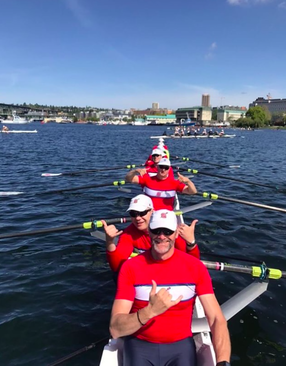 Photo taken by Lia Roberds- the ECM men's boat at the Opening Day/ Windermere Cup Regatta Photo taken by Lia Roberds- the ECM men's boat at the Opening Day/ Windermere Cup Regatta Paul Colvin is married with two daughters. One of his daughters began rowing during her freshman year of highschool. By her junior year Paul took up the sport as well. “I had an erg since early 90’s, and it sat unused for about a decade. Though I had used it a bit and knew it was a great workout,” Colvin said about his rowing beginnings. Once he was part of the team he was hooked. Andy Roberts, like Colvin, had never rowed in his life before starting the sport as an adult. Roberts had joined Sammamish Rowing Association’s (SRA) Learn to Row (LTR) program in 2012 and had a huge group of great people in his LTR class. “I needed to do something competitive. I played soccer before, but my teammates kept getting injured,” he said. Like Colvin, Roberts had caught the rowing bug and stayed with SRA year after year, unlike many of his fellow LTR teammates who seemed to fizzle away. Paul Meyer rowed a bit during his school years in the Netherlands, but wasn’t particularly looking to get back into rowing until his wife took it up. When they moved to the United States, his wife picked up rowing at SRA to stay fit. At the end of her Learn to Row experience, she introduced Paul to Jenny Proby and he eventually joined the ECM team. Meyer said, “it took a couple of years to get all the fitness back, but I'm happy I did it.” Then there was Mike Fitzner who moved to Washington in 2004 from California. At that time, SRA offered winter conditioning classes that appealed to Fitzner. The crazy good workouts were matched with terrific coaching as Fitzner learned proper erg form during his initial time at SRA. However, other sports drew Fitzner away from the old boathouse for a few years before his return. “I introduced a colleague at work, Leslie Moser, to erging. She ended up doing LTR, and told me it was the best thing ever. She eventually wore me down to try actual rowing so I gave in,” Fitnzer said. He loved it and has put his entire focus on rowing ever since. He too commented on the fact that his LTR class seemed to dwindle out despite the strong sense of community and fun. Just a few years back the men on the Evening Competitive Masters (ECM) were few and far between. Fitzner, Colvin, and Roberts are some of the men who have stuck around the longest to see the team really grow. Fitzner said, “Over the years we tend to lose people, the ones who stay are the ones who would do it for life.” All of the men agreed that while many LTR participants love rowing not all of them are ready for the commitment that comes with rowing. Roberts commented, ““At our age and the time we row, life can get in the way. Rowing at 6:30pm at night is hard for some people.” Time, family, work, and other commitments can make it hard for people to consistently make it to the boathouse. Fitzner added, “If you want to row competitively you cannot half-ass practice and the time commitment. You won't advance in your rowing technique and make better boats. That is going to weed out and frustrate people.” It’s true that it takes a certain type of person to stay committed to the sport. All the men agreed that they don’t just row- rowing is a part of them. Fitzner said, “My friends have no idea how difficult this is,” to which Roberts added, “but they all know you row.” Despite the dedication it takes to be successful in rowing, these men along with all of our other members, see their dedication as totally worth their time. Slowly but surely the ECM team has seen growth in the amount of men on the team, as well as its competitiveness. Fitzner, Colvin, and Roberts have simply attributed that growth and development to the strong community and time. Colvin said, “I can’t say I’ve actively recruited anyone- it’s a hard sport to recruit for. If people show up you hope they are having a good time and have that desire to work hard and stick with it.” Meyer said that Colvin and Roberts were incredibly encouraging during his entire time on the ECM team. He said, “To me, Paul and Andy have been a constant in the time I was with ECM. A couple of years ago, ECM sent a Men’s 4+ to the Head of the Charles Regatta. That was not a completely ideal journey (we had to replace one of the rowers at the last minute), but it set the stage for what is possible. This ignited the initial ambition and it has only grown since.” Roberts added that they lead by example. “We are working our asses off and have fun while doing it, and people see that. Having people come in seeing we are succeeding now and seeing we started out where they started out is a big factor in having people stay.” All of these men came to join ECM through the LTR program. It took time for them to be at the level they are now. They remember how hard it was in the beginning and that memory reminds them to encourage new members as they embark on their own rowing journeys. The men agreed that when they see someone with athletic potential come up through LTR they encourage the individual to stay. Coach Lee Henerson of the ECM team talked about the team growth as well. “It has been exciting and rewarding to watch the team over the years. The thing that I preach is to own your experience and there’s a core group of guys that have bought into that. Paul [Colvin], Andy, Paul [Meyer], and Mike have definitely bought into that among others. These rowers have been through the ups and downs and thick and thin. We’ve been able to build up through the LTR ranks and that core group has gotten stronger.” Henderson added, “The group has continued to grow and buy into the ‘own your experience’ philosophy. They run workouts together and make it fun. A cadre of guys have been coming together all of July. The improvements we’ve seen are a result of that philosophy.” Henderson also attributed team growth to the intentional targeting of better racing opportunities. ECM has begun adding bigger and bigger events to their racing schedule such as the Head of the Charles Regatta. The increase in exciting racing opportunities has correlated to increases elsewhere in the team. Those increases were in numbers and competitiveness. Fitzner said about their progress as a team, “we have rowed splits this year we never thought possible. In contrast to other crews or other crews from other clubs, we don’t have anyone who rowed collegiately in our men’s eight. We all started novice year here at SRA.” All of them agreed that their favorite SRA memory was this year’s Opening Day. Fitzner said, “our rowing then was so good it felt like the season was over for me, as I didn’t think this experience could be topped. We came in second place even though we went in with no expectations. It was an awesome race out of the gate. The whole 2K with the boats and yachts on starboard side, with the noise, and the way the boat felt- it was perfect. Stars aligned.” Their progress over the years has been due to many factors; hard work, dedication, patience, and an incredible support group. They’ve talked about the tremendous impact that excellent coxswains like Amy Shotwell and Lia Roberds have had on their progress. Fitzner, Colvin, and Roberts all agreed that Roberds’ coxing skills and dedication to them has made all the difference in many of their practice and races. They trust her to help them get the best practice in possible or race their best race, and say she provides a unique benefit in that she acts as both a skillful coach and coxswain when in the boat. Coach Henderson mentioned that Shotwell has been instrumental to the team for years and having Lia around to coach and cox is an incredible benefit for the team. With their recent success and incredible progress the men now feel like they belong. By that they mean they feel that they are finally good enough to be worthy competitors with fellow SRA teams, local crews, and even national competition. Henderson said, “I believe having multiple strong competitive teams within SRA just makes for an overall healthier program. It gives options to athletes that I find exciting.” However, rowing prowess isn’t the only strong part of the team. Their bond as a group has grown too. Roberts said, “One of the best things about ECM are the things we do outside of the boathouse. We do a rowing camp at Lake Samish. It’s such a great way to start the new year. We get such great bonding, rowing, and the very spartan cabin accommodations add to the overall experience. It makes ECM a unique place!” Colvin added, “We have fun together. The first and third Thursdays of the month we drink beer as a team and hang out.” Meyer also loves the third Thursday beers as well as the team's Christmas party. Strong bonds, incredible work ethic, and years of patience and determination have paid off for the members of the ECM team at SRA. Fitzner finished with, “It’s a great time to be in ECM right now. We have a great group of guys,” which Colvin agreed with. “And a great coaching staff,” Roberts added quickly, “Lee, Dennis, Lia, Matt- all of them.” 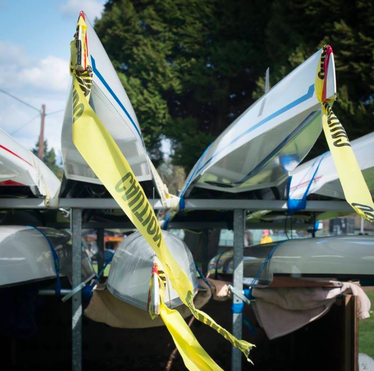 It was the middle of a sweltering hot day in Utah when Steven Freygang, then the Experienced Junior Boys Coach, noticed smoke in the mirror of the passenger side of the trailer. He and Dennis Ferrer were in the midst of driving the Sammamish Rowing Association (SRA) trailer back from Junior Nationals hosted in Florida. SRA had an incredible presence at the regatta. All three boats(Varsity 8, Ltwt. 8, Ltwt. 4) had made the finals and Freygang noted their varsity crew was “off the charts good.” It was an exciting time for Ferrer and Freygang, but that elation was also met with disappointment. During the varsity 8+’s grand final, their cox box failed in the first 500 meters. The crew responded by surging ahead, but soon ran out of gas as their race strategy was lost. They still had an impressive finish, and ended up being the fifth fastest junior men’s varsity 8+ in the country, but they were disappointed when thinking about what could have been if the cox box had not failed. In a hurry to get the trailer back to Sammamish Rowing Association (SRA) in time for Masters Regionals, Ferrer and Freygang missed the opportunity to fully debrief with their athletes after nationals. As they drove towards home with a trailer loaded full of SRA and other Pacific North West team boats, they definitely felt a little low. Then came the smoke from the back of the trailer. Freygang jumped out of the truck and hurried to the back of the trailer. The rear axle was on fire. Grabbing their only water bottle from the truck, he dumped it on the axle to put out the fire. “We stood there and didn’t know what to do,” Freygang said. On the side of the road in the middle of nowhere in blazing heat with no one around, they had no idea what to do next. Their only idea was to call AAA. A representative from AAA came out, took one look at the 20,000 pound trailer and truck, and confirmed their fears that he really couldn’t help. The AAA man stayed with them though as they desperately called local coaches and teams in hopes that someone could help move their boats onto another trailer while they figured out what to do. No one was responding. The AAA employee ended up helping them lift the axel just barely enough with a steel bar, assuring Fregygang and Ferrer that some trailers could be driven on just one axle for a short time. He drove behind the trailer as Freygang and Ferrer drove under ten miles per hour to the closest semi-truck repair shop. They made it and pleaded with the repair shop workers to let them store the trailer there overnight. They agreed to help, and Freygang and Ferrer left the trailer behind as they drove off in the truck in search of a place to stay. Every hotel and available room seemed to be booked except for one honeymoon suite at a local bed and breakfast. They accepted the room which also came with champagne and breakfast in bed. Eventually the two drove home in the truck, leaving the trailer behind in Utah. It wasn’t until a month later that a special ordered part arrived at the semi-truck repair shop, and was used to repair the trailer. Simon Williams drove down to Utah with his wife, picked up the trailer, and SRA’s worst trailer experience was now in the past. Not all trailer driving experiences are this dramatic and full of despair, as Freygang recalled. However, driving a 20,000 pound fully loaded trailer is no easy task. While it doesn’t require a specific license to haul in most states, SRA still requires its coaches to do some training. Matt Lundberg, a seasoned coach and trailer driver at SRA, said, “To be able to drive the trailer you don’t need any sort of professional license. Like with an RV- it’s scary to know not always the most qualified people are driving it. At SRA you go through training that entails being a co-pilot some number of times. After that, when a pilot gives you the go-ahead you are good to drive.” Lundberg has driven the trailer for nearly a decade. He says that a good amount of nerves is always a good thing for trailer drivers to have. It keeps them alert whereas a confident trailer driver may not notice when something is wrong. So what does trailer driving entail? A lot of stops for gas and coffee. Lundberg said, “if your co-pilot drinks coffee you stop for coffee.” While logging a lot of hours on the road isn’t always the most exciting task to take on, Lundberg still enjoys many parts of hauling the trailer. “Going from forests in Washington to mountain to plains and everything else in the other states is really neat. I enjoy seeing the different landscapes. Montana is very diverse going from evergreen forests and mountains to badlands type landscapes.” Time is passed with plenty of music, podcasts, and conversations with you copilot(s). Some of Lundberg’s favorite moments are when they stop for gas, because people always come up and ask about the trailer and boats. He enjoys explaining where he is going and educating people about racing shells. He even once met people from Sammamish, Washington when he was halfway across the country! So far Lundberg has had great success with driving the trailer, and has experienced practically no emergencies. He did however, drive a trailer through a hurricane in Florida, and happened to have the bow of a boat crash through the rear window of the vehicle he was driving at the time. Lundberg wanted all rowers to remember one thing about driving the trailer - boats need to be strapped down tight! “Highway speed is same as hurricane speeds. Strap down boats tightly please!” He said. Over the years Lundberg has had many co-pilots, but he did disclose who his favorite co-pilot of all time was. His wife has been able to accompany him over the years on trailer drives so she was his obvious pick for his favorite co-pilot. When they drive the trailer to San Diego they make a road trip out of it and try to stop at fun spots and overlooks during the journey. Driving the trailer takes a lot of hard work, hours, and thoroughness to ensure successful arrivals and departures. It’s an essential job to ensure we can provide national racing experiences to our members at Sammamish Rowing Association. Even though trailer driving is hard labor - it’s a labor of love. The next time you see the trailer loaded up and ready to go, be sure to give the straps an extra look, and slip a gift-card for coffee into the driver’s seat if you have the chance (or in Lundberg’s case, a PB&J sandwich). 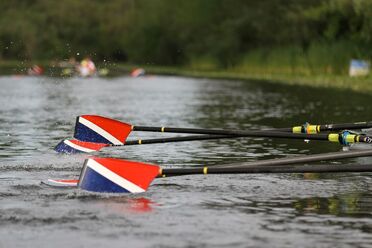 USRowing Nationals took place from July ninth through the fourteenth. The athletes who went had trained for the three weeks prior to the event nearly two times a day. “ We wanted them to experience training at a higher intensity level, and wanted to help them understand the impact of that on their nutrition, sleep and recovery. They also got the opportunity to row in smaller boats (2-, 1x) which is harder to do logistically during the school year,” Eliza Dickson, Sammamish Rowing Association’s Junior Program Director, said. Alec Willett, Ethan Currie, Anna Barry, and Eliza Dickson coached twenty-four junior athletes, who all had to apply for the training camp during their spring season. Coach Dickson said she, “really enjoyed watching the group come together as well as seeing how the athletes took ownership of the experience . Regardless of results, it is also gratifying to watch them learn so much in such a short period of time.” Many of the athletes were seen coming to the boathouse early before many of their double practices to get in extra work. Their dedication to training was remarkable. “They did an amazing job,” Dickson added, “many of our athletes did seven 2k races in three days. That’s like an entire season of spring racing!” Junior rower, Eli Rubenstein, noted how difficult but gratifying the long weeks of training were. He said, “During the weeks of training before USRowing Nationals it was extremely difficult waking up early and practicing in a variety of boats six days a week, which introduced me to a whole new type of training that pushed me to new limits. Alongside the long morning water practices- the land days three days a week were very difficult. With all these practices a lot of food and sleep was needed, but in the end all the hours were worth it.” Many of the rowers had their own reasons for doing the camp, but Rubenstein said, “I decided to do this camp to have an opportunity to get more one on one time with the coaches so I could build relationships with them early on. One of my main goals personally for this camp was to improve my rowing technically so I can have the best chance possible for the upcoming season. This experience helped me as a rower to really advance my rowing to another level, be able to compete against the fastest nationally, and also mentally be able to push myself beyond limits I didn't know existed.” Philip Popa, a junior coxswain of the group, also gave insight on to why he did the camp. “I wanted to gain more racing experience,” he said. “More than that, I also wanted to gain an overall feel for how the experienced boys’ team functions, since I will be joining them in the fall. As far as racing was concerned, I just wanted to place as high as possible, and be able to say after the regatta that we did our best whatever the results ended up being.” Popa and Rubenstein were both on the Junior Boys Novice team last fall and spring and will now be on the Experience Junior Boys team. Even though the training was long, difficult, and tiring, the athletes still had plenty of fun. Rubenstein commented on one of his favorite memories during the trip to Ohio. He said, “One of my favorite moments was the day raced in the Semi-Finals for the U17 4+. Going into this race our whole boat were novices and had the least amount of experience. We were given a speech from Coach Liza and Ethan before our race that opened up our eyes to a whole new world. They told us we were the future of Sammamish [Sammamish Rowing Association], and this race was for us to push our limits more than any other. Our race was the hardest we had ever pushed ourselves and because of that a sense of pride comes to me. Although we didn't qualify for the Grand Finals we did our best and learned a lot along the way.” Whether or not our juniors got a medal- they all came away from USRowing Nationals with successful accomplishments. From pushing their limits, forging new relationships, and discovering their unbounded potential- every junior rower has a reason to be proud of their performance in Ohio. Sammamish Rowing Association did however take home a second place finish in the Women’s U19 2- Final, and second place in the Women’s U19 4- Final. Congratulations to all of our athletes for your amazing growth, development, and success during USRowing Nationals training and the regatta! |
Archives
April 2023
Categories
|
|
Sammamish Rowing Association
5022 W. Lake Sammamish Pkwy NE Redmond, WA 98052 [email protected] 425-653-2583 |
Mailing Address:
Sammamish Rowing Association P.O. Box 3309 Redmond, WA 98073 |
|

